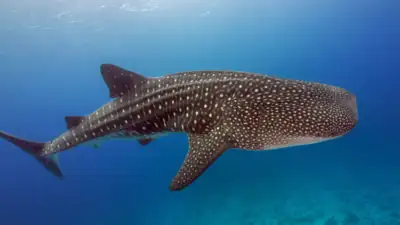ARTICLE AD BOX

The oceans have numerous hidden surprises, and some of them come as extraordinary largest animals living on Earth. One among these huge creatures is the Whale shark, which is the largest in the world.Recently, one of these species was spotted off the Pacific coast and has broken size records across the marine biology world.Whale sharks play an important role in ocean ecosystems, and this latest discovery reminds us that we still have much to learn about them, as such discoveries help researchers piece together more of the puzzle about how these creatures live, migrate, and survive in today’s changing oceans
A 60-foot wonder of the sea
Whale sharks usually grow between 18 and 33 feet, but the one recently seen in the Pacific was a surprising 60 feet long, about the length of a city bus.
According to Animals Around The Globe, this makes it one of the largest whale sharks ever recorded. Despite their huge size, these fish are filter feeders that quietly glide through the ocean while eating plankton and small fish. Their gentle nature and beautiful white-spotted skin make them stand out among the other creatures in the ocean.Whale sharks help to keep the marine ecosystems healthy. By feeding on plankton, they help to keep the balance of the food chain and prevent overgrowth that could harm coral reefs and fisheries.
Their long migrations across oceans also help circulate nutrients between regions. The regions where these massive whales live are often considered as a healthy marine environment, and make them vital indicators of ocean health.

The mystery of their long journeys
Even with satellite tracking, scientists are still puzzled by whale shark migration routes. These giants can travel thousands of miles, but where they go to breed and why they follow certain paths remains unclear.
The discovery of such a large individual hints there could be unknown migratory routes or feeding grounds that science is yet to explore.

Threats and protections
Whale sharks face threats like overfishing, climate change, and pollution. Their slow growth and low birth rates make recovery from population loss difficult. But some global conservation programs and marine protected areas are helping to protect the population and are preventing them from reaching the brink of being endangered. Citizen science efforts, like tourist sightings and photo sharing, also support monitoring and research.Furthermore, modern tools like satellite tags, underwater drones, and DNA testing are giving scientists new ways to study whale sharks. These advances are helping us understand their behaviours, migrations, and breeding habits.



.png)
.png)
.png)
















 3 hours ago
3
3 hours ago
3









 English (US) ·
English (US) ·